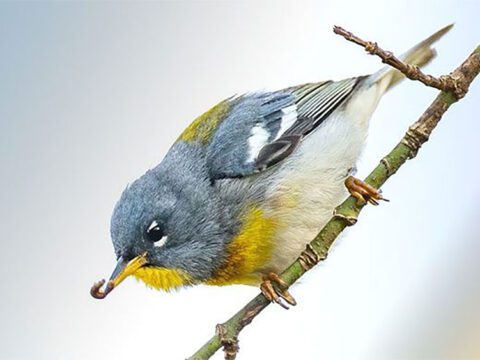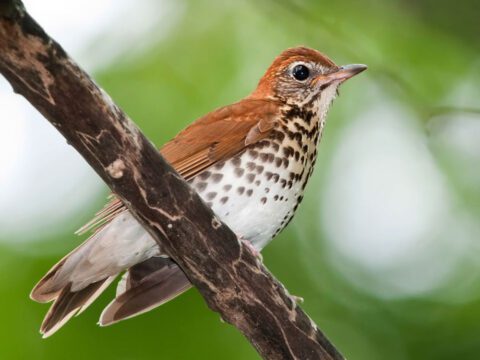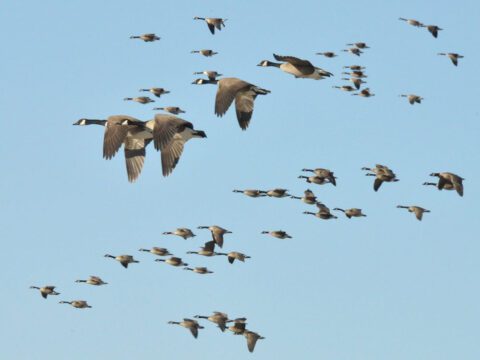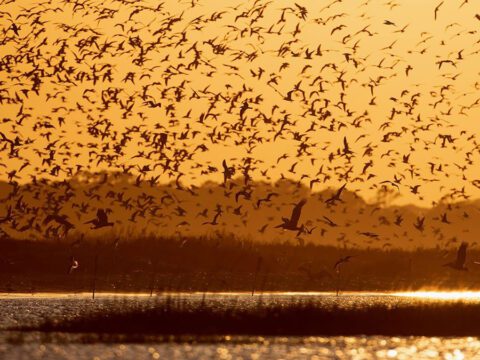How to Plan a Birding Day Trip With eBird Hotspots
By Gustave Axelson December 19, 2013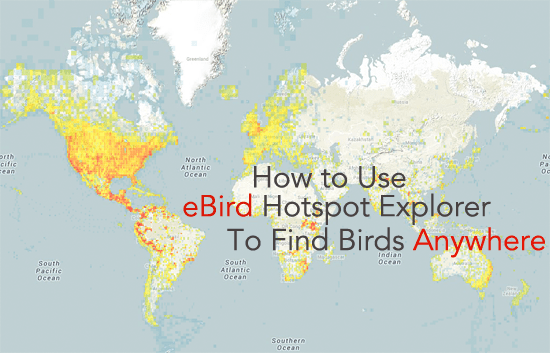
“Hold Day Open for Birding.” Five sweet words blocking out Nov. 11 on my calendar. Veteran’s Day. Kids off school. Perfect excuse for a birding day trip with the family.
But where to go? I’m a relatively recent transplant from Minnesota to the Cornell Lab here in Ithaca, New York, and I needed some help. Local bird clubs are a great source of info, but this was an impromptu trip I was planning at the last minute (and most bird clubs don’t offer 24-hour travel advice). Birding listservs keep you up to date on notable finds, but they’re too scattershot to map out a trip. Then there’s eBird, with its database of 150 million sightings—and a new tool called Hotspot Explorer that lets you zero in on where the most bird species have been seen.
Hotspot Explorer tallies all the eBird records at each location on a Google map and then color-codes them by the number of species reported. Birding points of interest pop right out at you: red spots are the hottest; blue spots have the fewest species reported. Each spot is clickable to reveal a complete history of birds seen there, with daily updates as new eBird checklists are uploaded. With Hotspot Explorer, planning my Veteran’s Day birding day trip became a game of connect the dots.
Using eBird Hotspot Explorer for Pre-Trip Planning
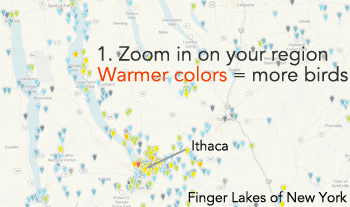 Scan for hotspots at 30,000 feet: Hotspot Explorer starts you on a map of the world. The first thing you can do is enter your location in the upper right-hand search box. Voila… a regional map decorated with pinpoints. Green = 100+ species; orange = 200+; red = 250+.
Scan for hotspots at 30,000 feet: Hotspot Explorer starts you on a map of the world. The first thing you can do is enter your location in the upper right-hand search box. Voila… a regional map decorated with pinpoints. Green = 100+ species; orange = 200+; red = 250+.
Result: Around Ithaca, in New York’s Finger Lakes region, the hottest spots hug the shorelines of Cayuga Lake (where songbirds mingle with waterfowl and shorebirds). So we decided to make our day trip a journey around the lake.
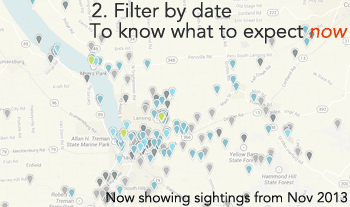 Narrow results for the dates of your trip: I was planning a trip for early November, so I didn’t need to know about spring warbler hotspots. I clicked on “Date:” and narrowed my results down to November only. The red spots on my map disappeared, but the remaining green and blue dots indicated the best bets for the season.
Narrow results for the dates of your trip: I was planning a trip for early November, so I didn’t need to know about spring warbler hotspots. I clicked on “Date:” and narrowed my results down to November only. The red spots on my map disappeared, but the remaining green and blue dots indicated the best bets for the season.
Result: Birding in the doldrums of November can be challenging, but I still found five hotspots along Cayuga Lake that might offer late-moving waterbirds and early winter migrants.
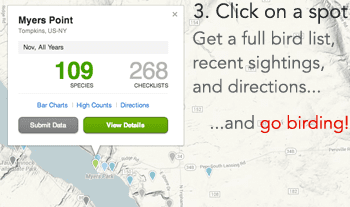 Check the details, spot by spot: Once you have a few target destinations in mind, click on them to find out what to expect. You can check bar charts to see which birds are common; search the result for target species; quickly see a list of recent sightings; and even get driving directions.
Check the details, spot by spot: Once you have a few target destinations in mind, click on them to find out what to expect. You can check bar charts to see which birds are common; search the result for target species; quickly see a list of recent sightings; and even get driving directions.
Result: Looking one spot at a time, I used the bar charts function to zero in on target birds. My kids really wanted to get their first Snow Bunting of the year, so I clicked through the dots on my map, revealing a pop-up window for each spot with a “Bar Charts” link. I just had to hit Find (Control–F) on the web page, search for the word “bunting,” and see if the hotspot had recorded Snow Buntings in November.
Next, I checked recent visits by checking the lower right column on the species page. A Glossy Ibis had turned up at Montezuma National Wildlife Refuge just two days earlier—a potential lifer for this Minnesota dad and kids. Finally, I clicked on the directions link, which opened a Google Map. I could even grab the latitude and longitude for each spot and paste the coordinates into my own custom Google Map for the day. We were ready to go.
(The eBird website offers additional help on using Hotspot Explorer.)
So How Did It Work? My Day Around Cayuga Lake in 6 Hours
The day dawned cold and gray, with spitting rain. Undaunted, the kids (ages 10 and 6) and I piled into the minivan and put our plan into action—six hours on a birding circumnavigation of Cayuga Lake:
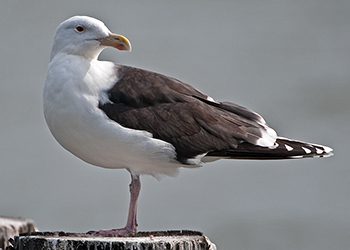 10:00 a.m.: Starting out at Myers Park. Our first stop, a city park on the southeastern shore of Cayuga Lake, was one of the few green dots on our itinerary (meaning more than 100 species had been reported during past Novembers). Birders had recently logged scoters, Brant, and a few Cackling Geese here. We were treated to lots of Mallards and gulls, and a few Great Black-backed Gulls stood out from the crowd—hulking gulls that dwarfed the Herrings and Ring-billeds. My kids were thrilled to see the world’s biggest gull. Here’s our Myers Point eBird list.
10:00 a.m.: Starting out at Myers Park. Our first stop, a city park on the southeastern shore of Cayuga Lake, was one of the few green dots on our itinerary (meaning more than 100 species had been reported during past Novembers). Birders had recently logged scoters, Brant, and a few Cackling Geese here. We were treated to lots of Mallards and gulls, and a few Great Black-backed Gulls stood out from the crowd—hulking gulls that dwarfed the Herrings and Ring-billeds. My kids were thrilled to see the world’s biggest gull. Here’s our Myers Point eBird list.
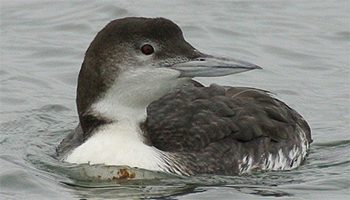 11:00 a.m:. Onward to Aurora Bay. Our next stop was a blue pinpoint at a wooden dock in the small town of Aurora. Recent reports of Red-throated Loons were a draw for us here. Only Mallards and gulls swam around the bay today, but just before reboarding the minivan my son spotted a Common Loon surfacing and then diving in a plip! and a ring of ripples on the water’s surface. The kids remembered paddling up close to loons in the Boundary Waters, so they appreciated the chance to see a loon looking coal-gray, after it had changed out of the black-and-white formal wear of its breeding plumage. Here’s our Aurora Bay eBird list.
11:00 a.m:. Onward to Aurora Bay. Our next stop was a blue pinpoint at a wooden dock in the small town of Aurora. Recent reports of Red-throated Loons were a draw for us here. Only Mallards and gulls swam around the bay today, but just before reboarding the minivan my son spotted a Common Loon surfacing and then diving in a plip! and a ring of ripples on the water’s surface. The kids remembered paddling up close to loons in the Boundary Waters, so they appreciated the chance to see a loon looking coal-gray, after it had changed out of the black-and-white formal wear of its breeding plumage. Here’s our Aurora Bay eBird list.
12:30 p.m.: Top of the lake at Montezuma. After stopping by a local bakery to grab a few scones for sustenance, we made our way to the top of Cayuga Lake, to one of the hottest hotspots on our route—Montezuma National Wildlife Refuge, with a total of 111 November species. The kids flipped to the Glossy Ibis page in their Sibley Guide, in anticipation of their encounter, but our target bird was nowhere to be found. However, a helpful refuge naturalist put us on two dun-colored Dunlins picking through a mudflat near the visitor center. My eldest son turned from Sibley’s ibis page to the Dunlin page: “They fly here from Hudson Bay? Sweet!” Our other consolation prize—a sack lunch at a reservoir overlook with a view of about 100 Tundra Swans below—was well worth the trip.
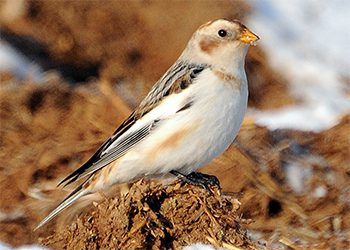 3:00p.m: Swapping Buntings for Kinglets at Cayuga State Park. Starting back down the west side of the lake we stopped in at this bare-bones park with little more than a drive-in campground and boat launch. It’s the kind of place we never would have thought to stop at on our own, but Hotspot Explorer said that somebody had seen Snow Buntings along the gravel campsite pads a week ago.
3:00p.m: Swapping Buntings for Kinglets at Cayuga State Park. Starting back down the west side of the lake we stopped in at this bare-bones park with little more than a drive-in campground and boat launch. It’s the kind of place we never would have thought to stop at on our own, but Hotspot Explorer said that somebody had seen Snow Buntings along the gravel campsite pads a week ago.
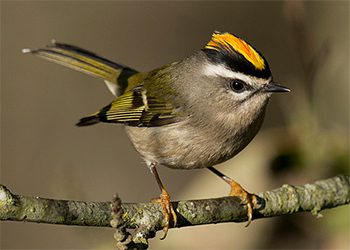 No buntings to be found on this day, but serendipity did pay us a visit—on a quick walk to stretch our legs, a Golden-crowned Kinglet dangled at the end of a white pine branch just five feet off the ground, so close that my six-year-old (who’s still trying to get the hang of binocs) could see the yellow-blazed mohawk atop its head. Sometimes it’s not the birds you want to see, but the ones that want to be seen. Here’s our Cayuga Lake State Park eBird list.
No buntings to be found on this day, but serendipity did pay us a visit—on a quick walk to stretch our legs, a Golden-crowned Kinglet dangled at the end of a white pine branch just five feet off the ground, so close that my six-year-old (who’s still trying to get the hang of binocs) could see the yellow-blazed mohawk atop its head. Sometimes it’s not the birds you want to see, but the ones that want to be seen. Here’s our Cayuga Lake State Park eBird list.
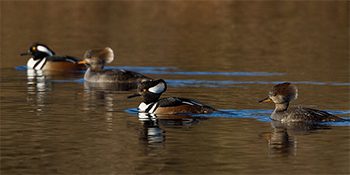 4:30p.m. Completing the Circuit at Treman Park in Ithaca. I didn’t tell the kids, but I was hoping for the Cattle Egret seen just the week prior (and 1,000 miles outside of its normal range) at our final stop, Treman State Marine Park in Ithaca. Instead our crew finished with 10 Hooded Mergansers quietly pushing along the water in a single-file line, out the canal and onto the lake—our family’s 30th species on the day. Here’s our Treman Park eBird list.
4:30p.m. Completing the Circuit at Treman Park in Ithaca. I didn’t tell the kids, but I was hoping for the Cattle Egret seen just the week prior (and 1,000 miles outside of its normal range) at our final stop, Treman State Marine Park in Ithaca. Instead our crew finished with 10 Hooded Mergansers quietly pushing along the water in a single-file line, out the canal and onto the lake—our family’s 30th species on the day. Here’s our Treman Park eBird list.
Based on a one-day trial, it was easy to see how Hotspot Explorer could be used to scope out historically bountiful migrant traps and ride the waves of recent sightings during the migratory high seasons. In our case—a dreary, overcast, unexceptional November day—the tool put us in the places to tally up some species on a day when birds were hard to come by. Hotspot Explorer can’t find the birds for you, but it can put you in birdy spots, with the latest info from top local birders about species in the area right now.
Another cool aspect of Hotspot Explorer—it gives you a chance to automatically pay-it-forward to the birding community. The kids really enjoyed reliving the day as we uploaded our lists to eBird. And it was pretty cool to think that there might be another birder out there who says, “Hey, a Dunlin at Montezuma. Let’s go take a look!”
(Images via Birdshare: Great Black-backed Gull by Roy Cohutta, Common Loon by Cameron Rognan, Golden-crowned Kinglet by Gregory Lis, Snow Bunting by Jim Paris, Hooded Mergansers by Greg Obierek.)

All About Birds
is a free resource
Available for everyone,
funded by donors like you
American Kestrel by Blair Dudeck / Macaulay Library

